School Board mulls budget; names new IHS Principal
by Robert Lynch; March 29, 2025
The Ithaca City School District (ICSD) will ask voters in about six weeks to buy eleven new school buses, part of an annual replacement and upgrading of the fleet. But unlike last year—and flying in the face of an eventual state mandate—not a single one of those buses will be electric.
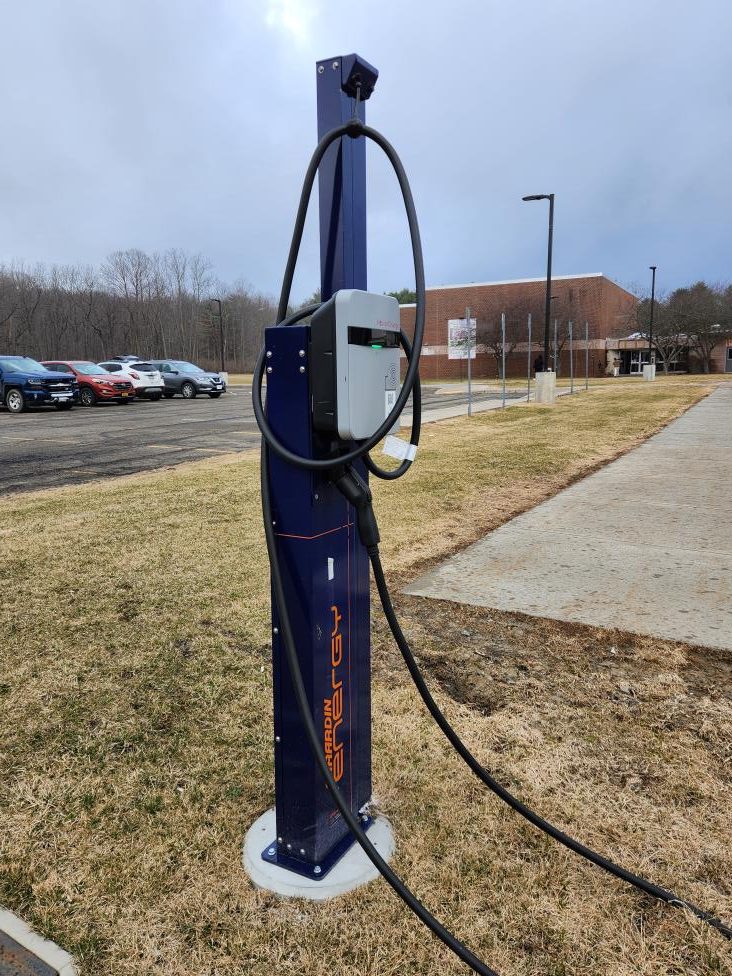
The Ithaca Board of Education’s decision March 25th to delay further fleet electrification accompanied the board’s first, all-member review of School Superintendent Dr. Luvelle Brown’s $169 Million proposed budget. Members also appointed long-time elementary principal and teacher Caren Arnold as Ithaca High School Principal, and heard more than a half-dozen ICSD faculty fault the district for offering raises too small during ongoing contract talks.
Hitting pause on electric bus purchases, according to ICSD officials, is not a matter of choice, but one of necessity. The needed electricity to energize those buses simply isn’t available.
“We know right now that whether or not ICSD was ready for electric buses, our infrastructure—and not just the ICSD’s infrastructure, (but also) the power grid—would not support us at this point in time being able to get electric buses,” Board President Dr. Sean Eversley Bradwell explained in support of the board’s self-imposed purchase moratorium.
Last year, the board first asked Ithaca district voters to buy four electric buses, part of an eight-bus transportation purchase. After an angry electorate rejected the initial request, doing so along with every other spending proposition on the ballot, the school board sliced the transportation request in half, voters approved the trimmed package, and two electric buses were bought.
But buying an electric bus does not necessarily bring to that bus the electricity it needs. Nor does it assure administrators and the public that a bus that runs on batteries will hold the stamina to finish its route. On both points, Ithaca finds the drive toward meeting the state’s electrification mandate an uphill climb.
Governor Kathy Hochul has ordered that beginning in 2027, all new school buses purchased in New York State must be electric-powered. And she’s ordered that a decade from now, every school bus must be zero-emission. Easy to dictate from the Governor’s mansion. Tough to implement in the field.
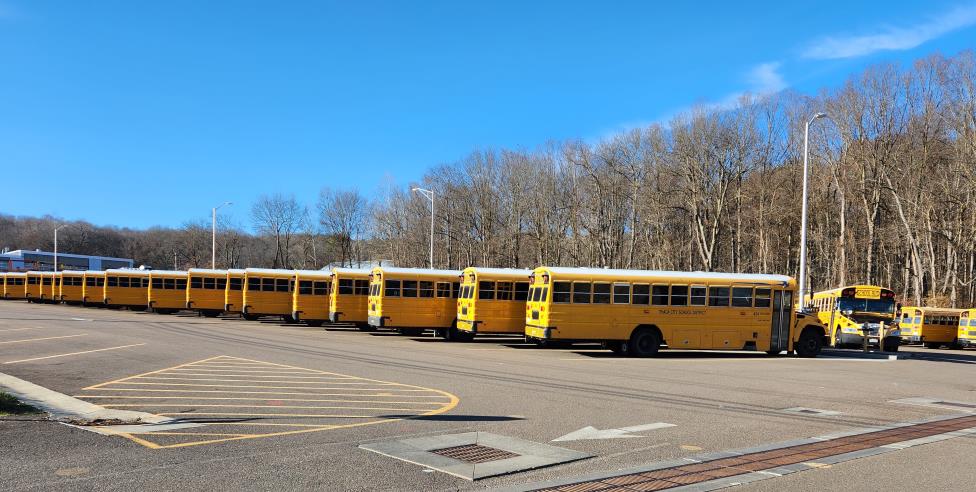
“At this point in time, the Governor’s mandate stands,” Eversley Bradwell cautioned the board. “There’s debate about whether that will continue, but by 2035, the entire ICSD fleet—(indeed) every public school district in the New York State’s bus fleet—needs to be full of zero-emission buses.”
At last count, the ICSD runs 88 buses. Only eight of them are now electric. The district maintains a ten-year replacement cycle. So on average, it needs to buy eight or nine buses every year. If the mandate holds, buying absolutely no electrics this year would prompt a latter-day game of catch-up.
Still, the nearly $2.27 Million spending proposition board members put onto the ballot this past Tuesday moves about as close to a Green New Fleet as practicality seems possible.
Each of the eleven new buses proposed for purchase would be an “ultra-low emission propane bus.” Six would be 70-passenger buses for “long range travel.” Three would be 30-passenger buses. Two more would be 66-passenger buses equipped for wheelchairs.
“Even if the district wanted to go all-electric, it takes some long-term planning,” Eversley Bradwell admitted.
“We will not be able to do our entire fleet electric,” a transportation official advised the board that night. “It’s just an impossibility at this point.”
Batteries that power electric buses are getting better, the transportation official told the board. But they’re still not good enough to enable every bus to finish its task without grinding to a halt. Under current technology, the official estimated, only “sixty percent” of buses could be electric.
Listed as “Proposition 2,” the proposed $2.27 Million capital appropriation would also include amounts for renovations at Cayuga Heights Elementary School “to include gymnasium dividers, exterior door repairs, and floor repairs.”
Prop. 2 spending would come from capital reserves, not new taxation. The spending will be decided in the May 20th referendum. Proposition 1 on that ballot will be the district budget. Budget figures will likely become final in early-April.
Specifics as to which kinds of buses the district would buy weren’t added to the school board’s agenda until the day of the meeting. Therefore, environmental activists had no time to organize opposition. The matter drew no public comment at the meeting. The board president acknowledges it could draw fire at future sessions.
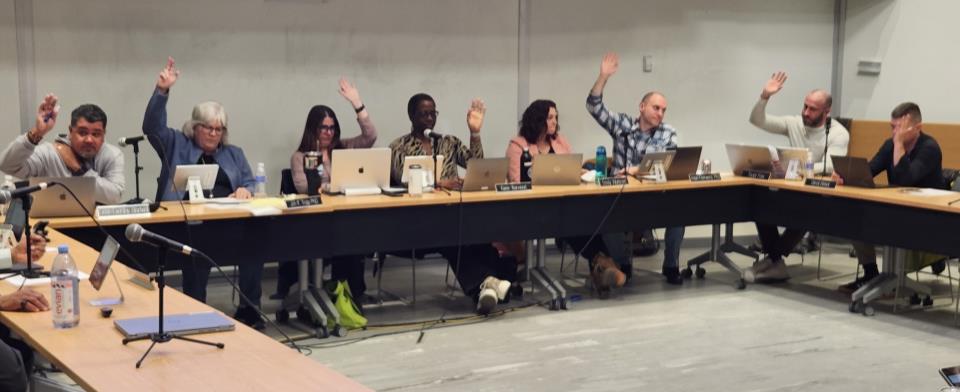
What’s more, school board members spent little time discussing the electric bus decision that night. The proposition’s authorization came as part of a routine resolution that set the date, times, and polling locations for the May 20th referendum. Emily Workman was seen abstaining from the authorization, but she never explained why she did.
Board member Karen Yearwood reported that those on ICSD’s student-based Climate Justice Alliance have already registered concerns.
“The student group was disheartened that we as a board of the school district are not moving ahead and purchasing electric buses,” Yearwood informed her colleagues. “And I reminded them that the community said that we need to slow down, and we listened to the community last year,” Yearwood stated.
Critics have faulted electric school buses over time for lots of reasons: their unreliability, an inadequate charging infrastructure, the risk of catastrophic fires, and of no small consequence, their cost. Each electric school bus costs close to a half-million dollars, about twice that of a standard diesel bus.
School Superintendent Dr. Luvelle Brown, Assistant Superintendent for Business Dominick Lisi, and a flock of four fellow administrators officially presented the school board the administration’s proposed next-year’s budget March 25th. Aside from its slightly reduced total, little had changed from a draft budget presented the board two weeks earlier.
And the unspoken question always hangs out there: Is it better to invest scarce resources to marginally help the planet or to substantively teach a kid?
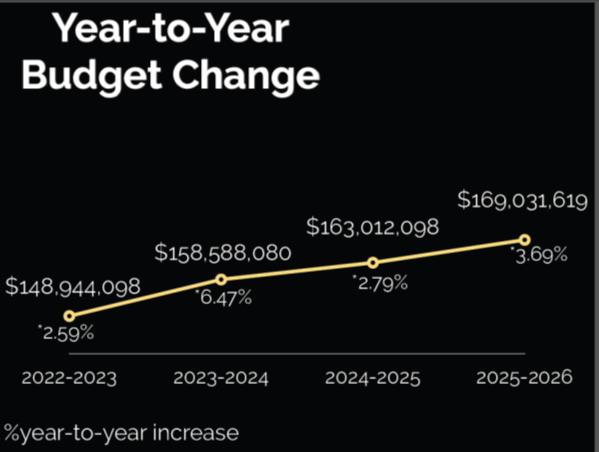
The 2025-26 budget the Superintendent now proposes, totals $169,031,619. That’s up 3.69 percent from the finally-approved budget of the current fiscal year, yet down from the nearly $171 Million budget that Dr. Brown had initially proposed for 2024-25, but which the school board—and then the voters—had demanded be reduced.
But less noticed, the new budget’s proposed spending has fallen almost $780,000 from the $169.8 Million draft budget presented the school board at an earlier session March 11. The change never drew discussion at the latest meeting. Yet a spreadsheet comparison reveals that a $500,000 reduction from a line labeled only as “Other Central Services” accounts for most of the difference.
Year-to-year, the Administration’s revised budget:
- Sets total spending at $169,031,619, up 3.69 percent (it had risen 4.17% two weeks earlier);
- Sets the total Tax Levy at $115,031,984, up 3.76 percent;
- Raises the projected Tax Rate from $14.80 to $15.20 per thousand, a 2.7 percent increase.
- Signals the district would tap nearly $6.8 Million from fund balances and reserves to moderate the tax levy. (For the current year, the budget drew upon fund balances by just over $7 Million.)
“We have needed to use our reserves and fund balances to plug budget gaps and budget holes,” Superintendent Brown admitted. He doesn’t like that practice. “We are using our savings account to fund operational things in a way we should not be doing,” Brown said.
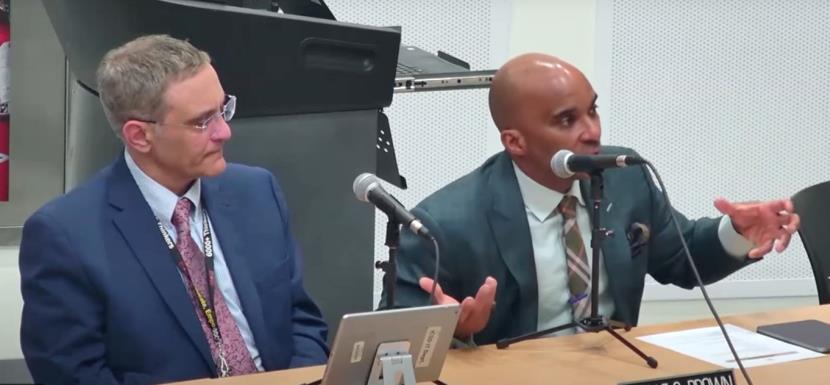
When the draft budget got its unveiling a fortnight earlier, only five board members had attended the meeting. Todd Fox, elected last year as a watchdog conservative, was absent then. So was Erin Croyle, a perceived liberal defender of a vibrant curriculum. But both sat at the table March 25th. Fox spoke little. But Croyle spoke much.
“We’re not looking at any cuts, but we’re also not looking at adding anything back that we had,” Croyle captiously asked of the Superintendent, Croyle referring to voter-demanded austerity measures imposed last summer that had canceled courses and downsized teaching staff.
Brown replied that he’d plan to keep “the same ratios and formulas” as were imposed last year, including a minimum 15-student class size. “That was a tough move and a difficult and challenging move for us last spring,” Brown conceded. “We’re getting used to that new approach to staffing;” but to Croyle’s point, “not a restoration.”
Disheartened by what she’d just heard, Erin Croyle pressed the superintendent further.

“Being a community member with three students in our district, I hear concerns about the programs we have being cut, things that are seemingly extras” Croyle cautioned. “People are really concerned that they’re going to have to be fighting to keep some of those things that feel like extras that really aren’t.” Could such programs “be on the chopping block,” Croyle asked?
“What we have right now will stay,” Superintendent Brown assured Croyle. “There are no recommended reductions in programs, period,” he insisted. Still, he qualified that changes in “enrollment patterns” and student interest could always affect what’s offered in the fall
Of course, that’s the superintendent’s intent. First the school board—and then the voters—must have their say. Another budget planning session could come as soon as April first. Discussion will definitely come at a meeting on April 8.
Add to the fiscal uncertainty the wild card of still-unresolved contract negotiations with unionized teachers.
As many as eight members of the Ithaca Teachers Association addressed the Board of Education at the start of its meeting. Most read from prepared statements—speakers willingly acknowledging a coordinated union campaign—each teacher calling upon the Ithaca District to elevate its salary offer from the current 4.59 percent annual increase to a much-larger 7.5 percent raise for each of the next four years.
Elizabeth Crawford, a high school instructor in advanced writing, said she’s needed to visit a food pantry and access public assistance. Sam Trechter, a teacher at Caroline Elementary, claimed he could earn $10,000 more annually by working in a neighboring district. Northeast Elementary School’s Meg Burke claimed she works three jobs and argued teachers shouldn’t need to work “side hustles,” in her case, cleaning houses, to make ends meet. Burke called her salary “barely survivable.”
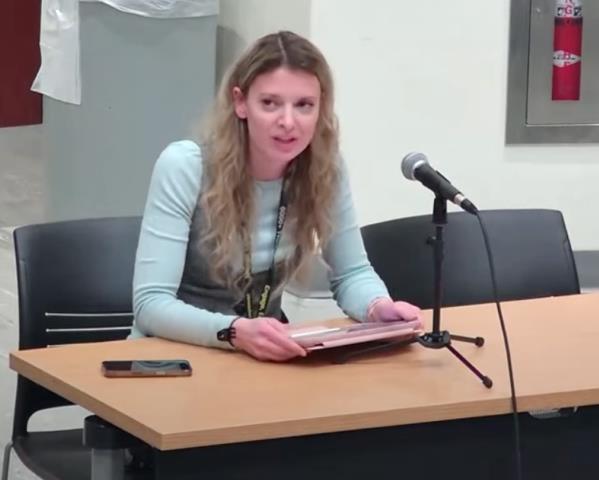
“ICSD is located in an Ivy League town,” Burke observed, reading from the union’s script. “Tompkins County has one of the highest median incomes in upstate New York. ICSD administrators are paid above the New York State average. This is a community that appears affluent by every measure except when it comes to retaining teachers.”
“If these are some of our most valuable educators, I just wonder what direction we can go to pay people what they’re worth,” Erin Croyle later questioned.
But then, again, what would happen if whatever budget the Board of Education hands up gets rejected at the polls this May similar to what happened last year? Board President Eversley-Bradwell wants a back-up plan. The president asked administrators to draw us a bare-bones “Contingency Budget” just in case.
Buses, budgets and teacher pay aside, what may carry the longest-lasting impact on Ithaca’s students came almost matter-of-fact, sandwiched between money items at an all-too-busy monthly meeting. Without discussion, the board elevated three-decade Ithaca teacher and administrator Caren Arnold to become the new Principal at Ithaca High School.
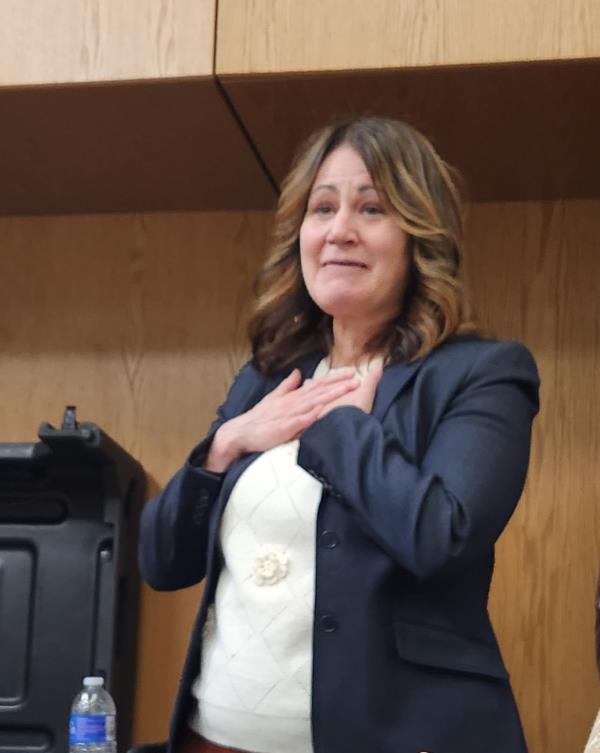
Arnold first joined the district as a teacher in 1993. She currently serves as principal at Caroline Elementary. Effective June 15th, Arnold will transfer to IHS, succeeding the retiring Jason Trumble, who’d served as IHS Principal since 2015.
Superintendent Luvelle Brown commended Arnold as “the best teacher I’ve ever seen; the most loving person I’ve ever seen.”
“Caroline Elementary is thriving because of her leadership,” Brown said of Arnold. “And she knew that we needed somebody at the High School, and she stood up and said, ‘Send me.’”
“Thank you for your support, Caren Arnold responded from the visitor’s gallery at York Lecture Hall. “I have really big shoes to fill.”
“I hope to show that we can all work together,” the High School’s principal-designee commented. “We have an opportunity to really bring our community together.”
Most recently, Vice Principal Martha Hardesty has overseen Ithaca High while Trumble has been on leave.
Superintendent Brown took the moment to commend departing principal Trumble as well.
“He has a High School he can say he served as Principal of for a decade that has been recognized as one of the best high schools in the nation,” Brown remarked. “The hardest job in this community… is being Principal in the High School,” the Superintendent asserted. And of Trumble: “I know what the toughest job is. And I know how long he works. And he did it well, and I love him.”
###

